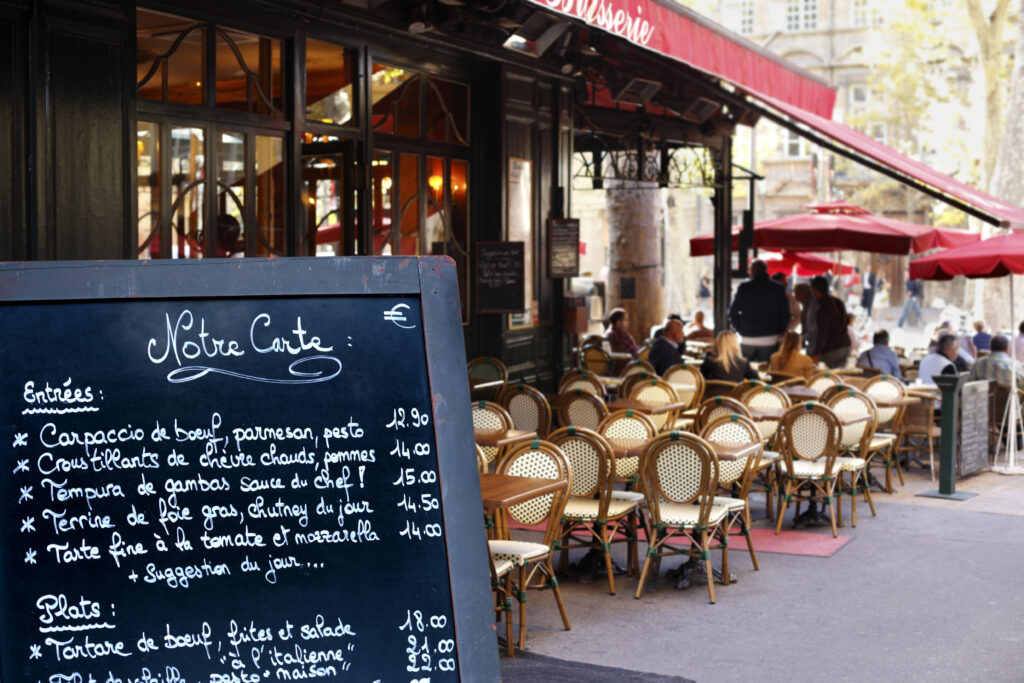
Did two weeks of watching the Olympics in Paris give you French food envy? The baguettes and cheeses, sauces, rich meat dishes, pastries—and oh yes, the wine. My mouth starts watering just thinking about it all. But do French people really eat that way? Let’s take a look, and then decide which French eating habits you might want to borrow. Even if it’s just while you still have Olympic fever.
They eat their biggest meal at lunchtime
If you are dining in France, you’ll notice immediately that breakfasts are light. Coffee or tea and a baguette with butter and jam is typical. Or toast with a sweet or savory topping (also known as a tartine). Sometimes it will be a croissant, and maybe a small glass of fruit juice.
By lunchtime, you’ll be pretty hungry, and that’s good because lunch is the meal in France. There is no scarfing leftovers at your desk at work. Whether cooking at home or heading to the office cafeteria or a restaurant, lunch is a multi-course, leisurely meal. The first course (entrée) is an appetizer. It’s often soup or salad, though sometimes the salad comes after the main course—it’s flexible. Then you’ll have a main course (plat principal)—chicken, pork, beef, or fish along with some vegetables. And you’ll finish with a little local cheese (le fromage) and often a small dessert (le dessert), frequently featuring fruit. Because lunch is so large and isn’t rushed, dinner is usually late, often around 8 pm or even later.
Takeaway: Eating your biggest meal midday is not a bad way to go. It can help your energy levels during the day and make snacking less likely because it helps quell hunger.
They don’t snack or eat “on the run”
Given how popular snacking is in the U.S., it’s hard to fathom an entire country that just doesn’t do it. Snacking throughout the day is considered unnecessary, which it probably is. French meals are complete (except for breakfast) and comprised of whole foods with quite a bit of fat. (Think meat, cheese, cream, butter, and nothing advertised as “low-fat” or “light.”) Similarly, it’s uncommon and often considered poor manners to eat while driving, walking, or on public transportation. There is a time and place for eating, and it’s not while dashing to a meeting or riding the Métro.
Takeaway: Meals that are balanced with protein, fats, and carbohydrates tend to keep people full longer. Whole foods with fiber also help with satiety. Snacking isn’t required for most people—in many cases, it simply has become a habit. What’s more, eating while driving or doing other tasks doesn’t register with our brains as easily. So when we do, we’re more likely to eat more than we intend.
They savor their meals
The French attitude toward food is that it deserves our attention and respect. Cooking with high-quality ingredients. Using careful preparation methods. And eating slowly in order to better enjoy and appreciate the food—that’s the traditional way to eat in France. It’s a very mindful way to eat (and I’m a certified mindful eating instructor, so this pleases me immensely). It’s not unusual for a lunch meal to take at least an hour, and frequently two hours.
Takeaway: It’s fair to say that the French eat mindfully without even trying—it’s just their cultural way. Putting together meals carefully, paying attention to the flavors, aroma, and appearance of the food, and taking plenty of time to enjoy it all—that is mindful eating. Plus, it takes your body roughly 20 minutes to communicate fullness level to your brain—no matter what size the meal is.
They eat small portions and rarely overeat
Portions of food are considerably smaller in France than they are in the U.S. But their enjoyment of the food is high—how is that possible? When portions are small but fat level is high, a meal’s calories“even out” without sacrificing satisfaction. There’s no need to quickly eat more or refill your plate when you thoroughly enjoy a nicely portioned, balanced meal.
Takeaway: Another mindful eating lesson here. Smaller portions of high-quality—even rich—food can be supremely satisfying.
Want to borrow some French eating habits?
Starting to change your eating habits takes some conscious effort. However, it can be done, and it doesn’t have to be overwhelming. (Nor does it require starting to cook French food!) If you decide to adopt some of the French ways of eating, select one thing to focus on. Once you decide on that, think of one behavior you can start doing that will support that change. It might be removing distractions while you eat, or taking at least 20 minutes to eat each meal. Then once that behavior becomes more automatic, add in another one, and so on. For more information on how to change your habits, check out this previous post.